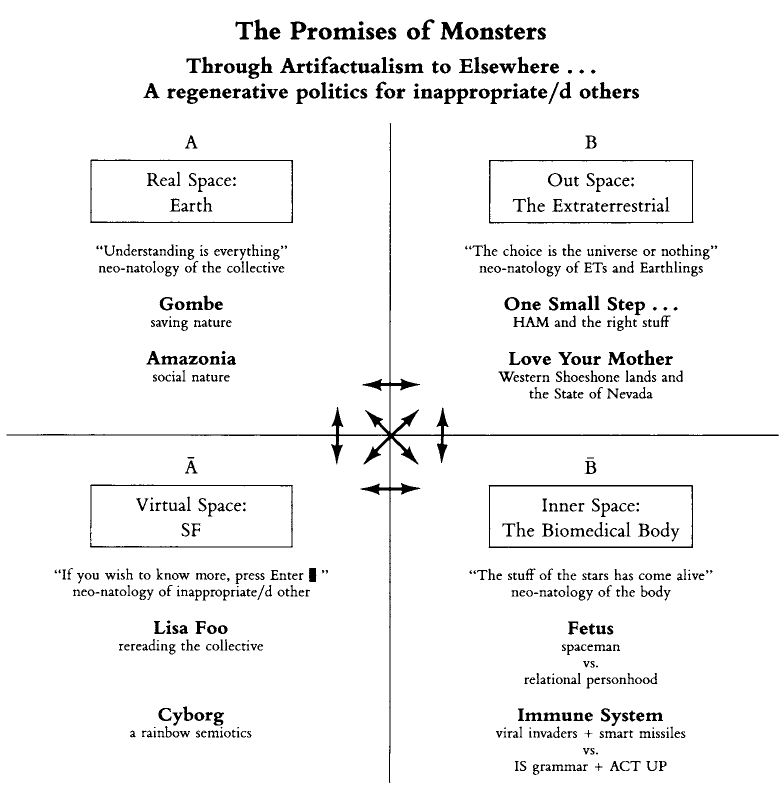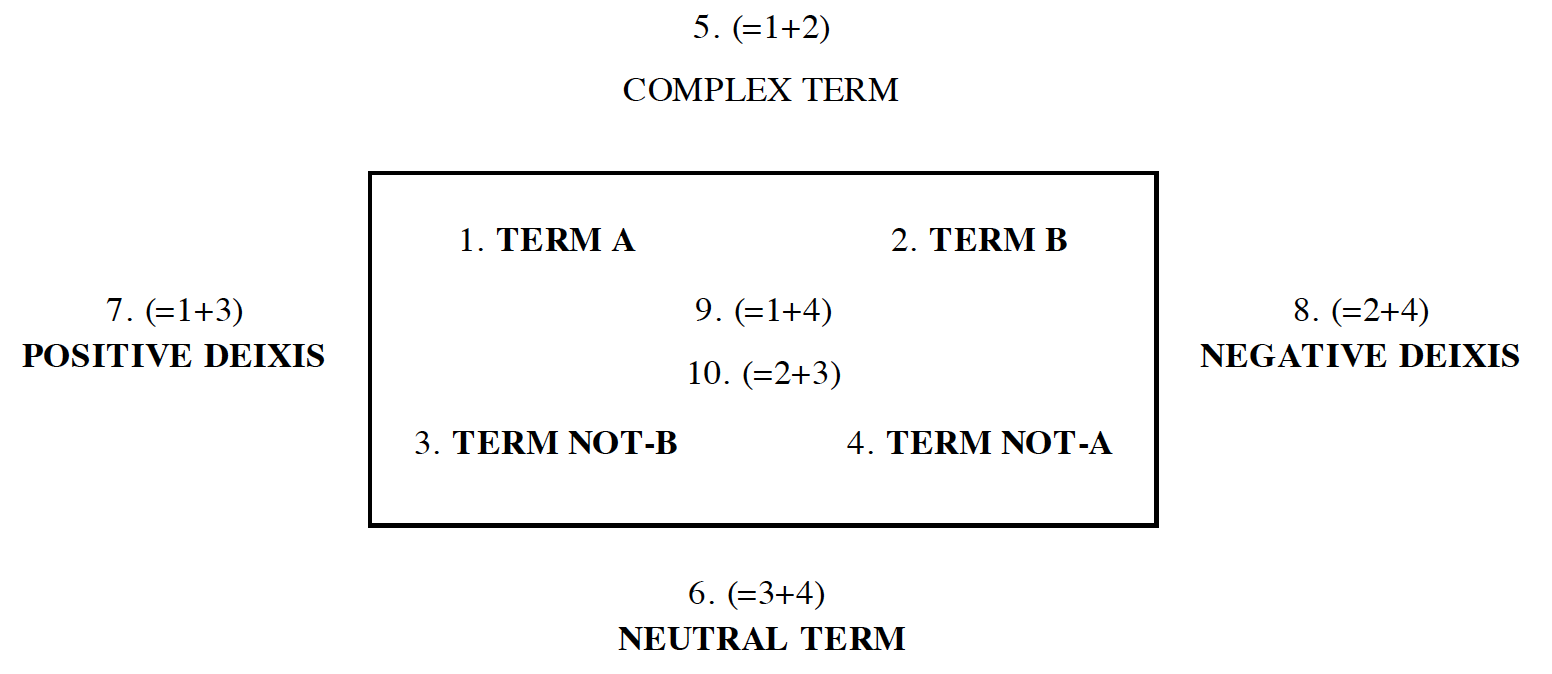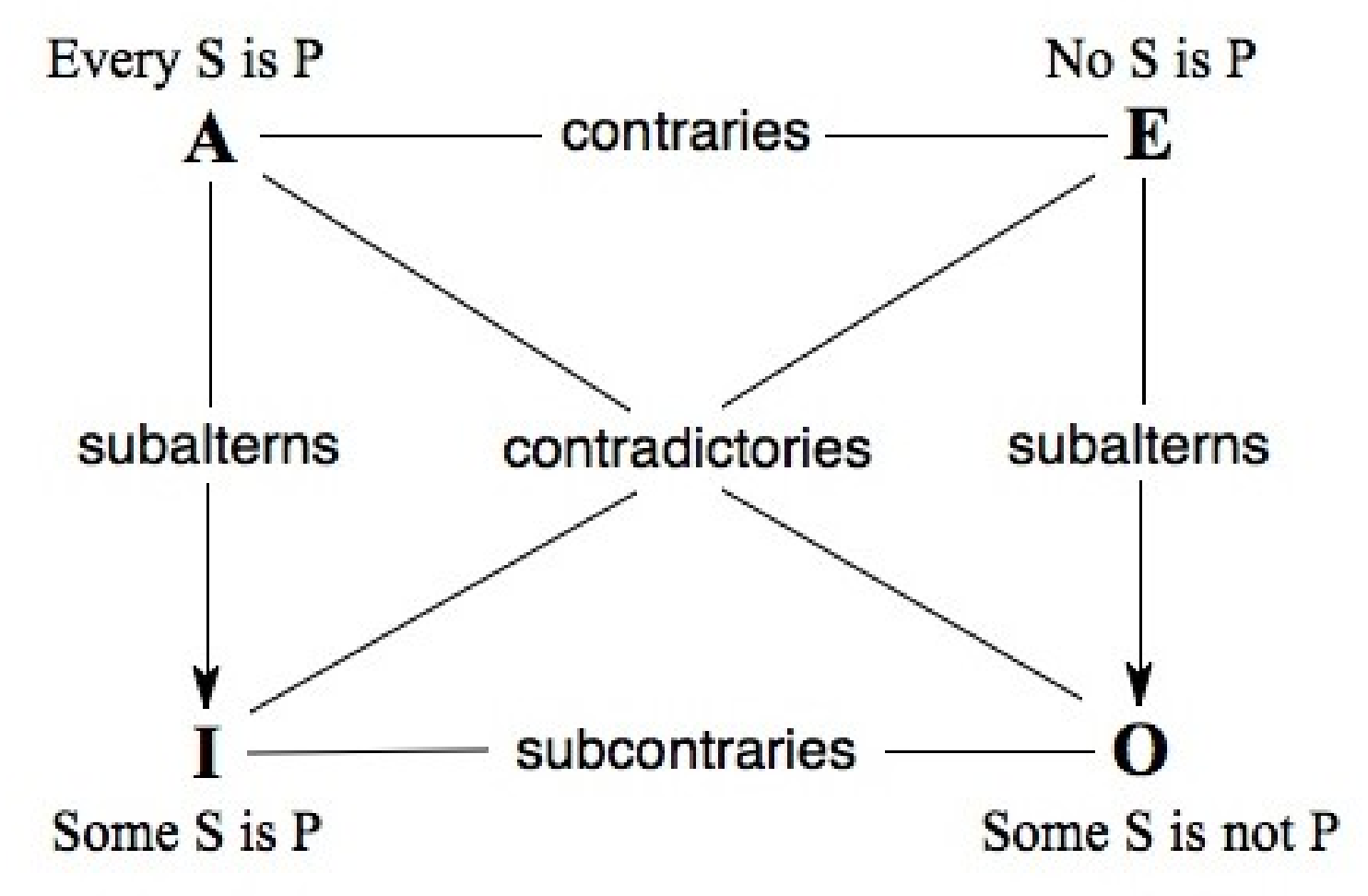CourseCompendium
Semiotic Square - Greimas
RELATED TERMS: Actantial Model - Greimas; In Medias Res
The kind of use that is made of Greimas’ semiotic square in the design of narrative environments is similar to that of Donna Haraway (1992: 304) in ‘The Promises of Monsters’. She notes that, in alliance with Bruno Latour, she will use “this clackety, structuralist meaning-making machine” to create a narrative other than “the rational progress of science, in potential league with progressive politics, patiently unveiling a grounding nature.” Equally, she will not create a tale that will be a demonstration of the social construction of science and nature that locates all agency firmly on the side of humanity.
Haraway uses the term amodern to refer to “a view of the history of science as culture that insists on the absence of beginnings, enlightenments, and endings: the world has always been in the middle of things, in unruly and practical conversation, full of action and structured by a startling array of actants and of networking and unequal collectives.”
She treats as a virtue the much-criticized inability of structuralist devices like the semiotic square to provide diachronic narratives. Instead, Haraway’s amodern history will have a geometry, “not of progress, but of permanent and multi-patterned interaction through which lives and worlds get built, human and unhuman.”
Thus, she uses the semiotic square to define four spaces as a means to explore how certain local-global struggles for meanings and embodiments of nature are occurring within those spaces. This, a contestable collective world comes into view that takes shape for us out of structures of difference.
Haraway’s (mis)interpretation of the structure of semiotic square is as follows:

The semiotic square as set out by Greimas is as follows:
 Source, Louis Hebert, 2006, The Semiotic Square
Source, Louis Hebert, 2006, The Semiotic Square
The similarity to the traditional diagram for the square of opposition, as presented below by Terence Parsons (2014), is striking. The top terms (A-B and A-E) are both in a relationship of contrariety (contraries); the diagonal terms (A-C, B-D, A-O, E-I) are in a relationship of contradiction (contradictions); the bottom terms (C and D, O and I) are also in a relationship of contrariety, but subordinate to the more general contrariety between the top terms (A and B, A and E) (sub-contraries), while the relationships between A-D and B-C, similarly to that between A-I and E-O, are sub-alterity (subalterns).

Greimas and the Semiotic Square
John Corso (2014) explains that Greimas introduced the diagram of the semiotic square in his 1966 essay, “Les jeux des contraintes ‘sémiotiques,’”. This essay was translated into English as “The Interaction of Semiotic Constraints” (Greimas and Rastier, 1968), published in Yale French Studies. In the essay, Greimas and Rastier (1968: 88) state that this “presentation makes it isomorphic to the logical hexagon of R. Blanché … as well as to the structures called, in mathematics, the Klein group, and, in psychology, the Piaget group”. Frederic Jameson (1972: 166) also notes a similarity to Levi-Strauss’s “culinary triangle” of raw-cooked-rotten.
References
Corso, J. J. (2014) ‘What does Greimas’s semiotic square really do?’, Mosaic: a journal for the interdisciplinary study of literature, 47(1), pp. 69–89. doi: 10.1353/mos.2014.0006.
Greimas, A. J. and Rastier, F. (1968) ‘The Interaction of semiotic constraints’, Yale French Studies, (41), pp. 86–105. Available at: http://www.jstor.org/stable/2929667 (Accessed: 14 December 2014).
Haraway, D. J. (1992) ‘The Promises of monsters: a regenerative politics for inappropriate/d others’, in Grossberg, L., Nelson, C., and Treicher, P. A. (eds) Cultural theory. New York, NY: Routledge, pp. 295–337.
Hebert, L. (2006) The Semiotic square, Signo - Applied Semiotics Theories. Available at: http://www.signosemio.com/greimas/semiotic-square.asp (Accessed: 22 August 2014).
Hebert, L. (2020) An Introduction to applied semiotics: tools for text and image analysis. Translated by J. Tabler. London, UK: Routledge.
Jameson, F. (1972) The Prison-house of language: a critical account of structuralism and Russian formalism. Princeton, NJ: Princeton University Press.
Parsons, T. (2014) ‘The Traditional square of opposition’, Stanford Encyclopedia of Philosophy. Spring 2014. Available at: http://plato.stanford.edu/archives/spr2014/entries/square/ (Accessed: 24 December 2014).